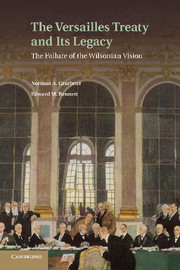Book contents
- Frontmatter
- Contents
- Preface
- 1 The International Order on Trial
- 2 The Road to Paris: 1917???1918
- 3 Versailles: A Study in Arrogance
- 4 The Retreat to Utopia
- 5 Manchuria and the Triumph of Non-Recognition
- 6 The Rise of Hitler
- 7 Challenge of the Dictators
- 8 The Elusive Response
- 9 Munich: The Continuing Escape from Reality
- 10 The Road to Prague
- 11 The Soviet Quest for Collective Security
- 12 The Coming of War: 1939
- Bibliography
- Index
- References
8 - The Elusive Response
Published online by Cambridge University Press: 07 October 2011
- Frontmatter
- Contents
- Preface
- 1 The International Order on Trial
- 2 The Road to Paris: 1917???1918
- 3 Versailles: A Study in Arrogance
- 4 The Retreat to Utopia
- 5 Manchuria and the Triumph of Non-Recognition
- 6 The Rise of Hitler
- 7 Challenge of the Dictators
- 8 The Elusive Response
- 9 Munich: The Continuing Escape from Reality
- 10 The Road to Prague
- 11 The Soviet Quest for Collective Security
- 12 The Coming of War: 1939
- Bibliography
- Index
- References
Summary
I
By 1937, Adolf Hitler’s challenge to Europe had become overt and threatening. Through two years of unrestrained defiance of the Versailles Treaty’s military provisions, German rearmament had become the dominant factor in European politics. Why Germany’s military effort had emerged as a special danger to Europe’s security, American diplomat Hugh R. Wilson explained from Switzerland. “The ability of a dictator to devote practically the entire resources of his country to armament,” he wrote, “cannot be matched by democratic countries in time of peace.” From Berlin, Ambassador William E. Dodd warned Washington that “the development of the [German] army and the recent throwing off of restraints of these past 17 years have brought matters back to a place where Germany is even more dangerous to the world than in 1914.” In his diary notation of April 20, 1937, foreign correspondent William L. Shirer recorded Europe’s declining confidence:
Hitler’s birthday. He gets more and more like a Caesar. Today a public holiday … and a great military parade. The Reichswehr revealed a little of what it has: heavy artillery, tanks, and magnificently trained men. Hitler stood on the reviewing stand in front of the Technishe Hochschule, as happy as a child with tin soldiers, standing there more than two hours and saluting every tank and gun. The military attachés of France, Britain, and Russia, I hear, were impressed. So were ours.
On May 1937, French Premier Leon Blum acknowledged to U.S. Ambassador William C. Bullitt that “Hitler had the political initiative on the continent of Europe….”
- Type
- Chapter
- Information
- The Versailles Treaty and its LegacyThe Failure of the Wilsonian Vision, pp. 141 - 165Publisher: Cambridge University PressPrint publication year: 2011



